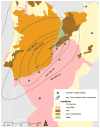Cost of microbial larviciding for malaria control in rural Tanzania
- PMID: 27500959
- PMCID: PMC5093077
- DOI: 10.1111/tmi.12767
Cost of microbial larviciding for malaria control in rural Tanzania
Abstract
Objective: Microbial larviciding may be a potential supplement to conventional malaria vector control measures, but scant information on its relative implementation costs and effectiveness, especially in rural areas, is an impediment to expanding its uptake. We perform a costing analysis of a seasonal microbial larviciding programme in rural Tanzania.
Methods: We evaluated the financial and economic costs from the perspective of the public provider of a 3-month, community-based larviciding intervention implemented in twelve villages in the Mvomero District of Tanzania in 2012-2013. Cost data were collected from financial reports and invoices and through discussion with programme administrators. Sensitivity analysis explored the robustness of our results to varying key parameters.
Results: Over the 2-year study period, approximately 6873 breeding sites were treated with larvicide. The average annual economic costs of the larviciding intervention in rural Tanzania are estimated at 2014 US$ 1.44 per person protected per year (pppy), US$ 6.18 per household and US$ 4481.88 per village, with the larvicide and staffing accounting for 14% and 58% of total costs, respectively.
Conclusions: We found the costs pppy of implementing a seasonal larviciding programme in rural Tanzania to be comparable to the costs of other larviciding programmes in urban Tanzania and rural Kenya. Further research should evaluate the cost-effectiveness of larviciding relative to, and in combination with, other vector control strategies in rural settings.
Keywords: Tanzania; Tanzanie; control vectorial; costes; costs; coûts; larvicidas microbianos; larvicides microbiens; lutte antivectorielle; malaria; microbial larviciding; paludisme; vector control.
© 2016 John Wiley & Sons Ltd.
Figures
References
-
- World Malaria Report 2014. Geneva: World Health Organization; 2014.
-
- RBM. Roll Back Malaria Progress & Impact Series. Roll Back Malaria Partnership; 2008.
-
- O’Meara WP, Mangeni JN, Steketee R, Greenwood B. Changes in the burden of malaria in sub-Saharan Africa. The Lancet infectious diseases. 2010;10(8):545–55. - PubMed
-
- Trape J-F, Tall A, Diagne N, Ndiath O, Ly AB, Faye J, et al. Malaria morbidity and pyrethroid resistance after the introduction of insecticide-treated bednets and artemisinin-based combination therapies: a longitudinal study. The Lancet infectious diseases. 2011;11(12):925–32. - PubMed
-
- Takken W. Do insecticide-treated bednets have an effect on malaria vectors? Tropical Medicine & International Health. 2002;7(12):1022–30. - PubMed
MeSH terms
Substances
Grants and funding
LinkOut - more resources
Full Text Sources
Other Literature Sources
Medical


